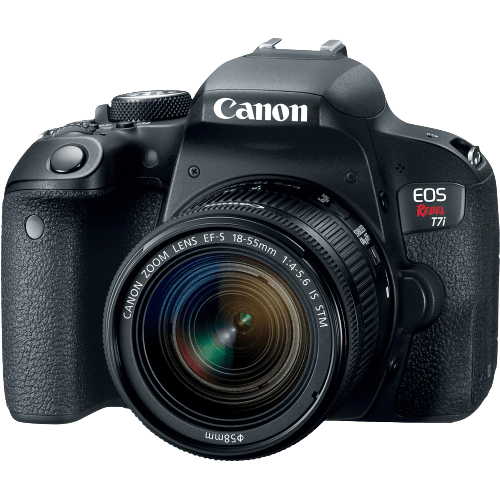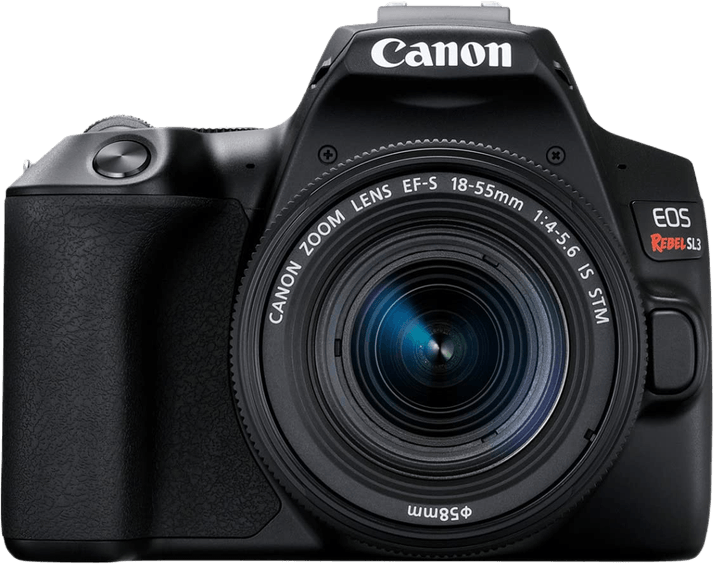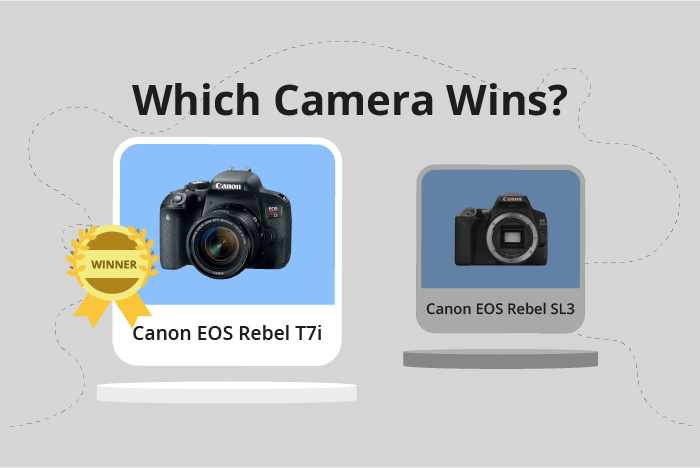Canon EOS Rebel T7i / 800D vs Rebel EOS SL3 / 250D Comparison
Canon EOS Rebel T7i / 800D

Canon EOS Rebel SL3 / 250D

The Canon EOS Rebel T7i/800D edges out the Canon Rebel EOS SL3/250D by just one point, scoring 64/100 compared to 63/100. Both cameras are DSLRs, released in 2017 and 2019, respectively. They share similar specifications, but the T7i/800D has some advantages over the SL3/250D.
The T7i/800D is slightly larger and heavier, measuring 131 x 100 x 76mm and weighing 532g, while the SL3/250D measures 122 x 93 x 70mm and weighs 449g. The extra size and weight of the T7i/800D might contribute to its higher score, offering better handling and stability.
On the other hand, the SL3/250D has a lower launch price of $599, making it more budget-friendly compared to the T7i/800D’s launch price of $779. This price difference might make the SL3/250D more appealing to some users despite its slightly lower score.
Considering the close scores, both cameras offer good performance and share many specifications. The T7i/800D has a slight edge in handling and stability, while the SL3/250D is more budget-friendly. Ultimately, the choice between these two cameras depends on the user’s preferences and priorities.
Canon EOS Rebel T7i / 800D vs Rebel EOS SL3 / 250D Overview and Optics
The Canon EOS Rebel T7i / 800D wins in the optics comparison with a score of 64/100, while the Canon Rebel EOS SL3 / 250D scores slightly lower with 61/100. Both cameras share several specifications, including 24 megapixels, CMOS sensor type, APS-C sensor size, and Canon EF/EF-S lens mount.
The T7i / 800D outperforms the SL3 / 250D in a few key areas. Firstly, it has a higher shooting speed of 6 frames per second, compared to the SL3 / 250D’s 5 frames per second. This allows the T7i / 800D to capture fast-moving subjects more effectively. Additionally, the T7i / 800D has a higher DXOMARK score for the sensor, with a score of 79 compared to the SL3 / 250D’s 64. This indicates better image quality and low-light performance in the T7i / 800D.
On the other hand, the SL3 / 250D has some advantages over the T7i / 800D. It features a more advanced processor, the Digic 8, which may provide better image processing capabilities. Furthermore, the SL3 / 250D offers image stabilization, a feature lacking in the T7i / 800D. This can help reduce camera shake and improve image sharpness in certain shooting conditions.
Taking all these factors into account, the Canon EOS Rebel T7i / 800D is the better camera in terms of optics, due to its higher shooting speed and superior sensor performance. However, the Canon Rebel EOS SL3 / 250D still has some noteworthy features, such as its advanced processor and image stabilization, making it a strong contender in its own right.
Canon EOS Rebel T7i / 800D vs Rebel EOS SL3 / 250D Video Performance
The Canon Rebel EOS SL3 / 250D emerges as the winner in terms of video capabilities with a score of 83/100, while the Canon EOS Rebel T7i / 800D follows with a score of 70/100. The 13-point difference highlights the superior video performance of the SL3 / 250D.
Both cameras share some common specifications, including a maximum video frame rate of 60fps and built-in time-lapse functionality. These features allow for smooth, high-quality footage and creative time-lapse videos in both models.
The Canon Rebel EOS SL3 / 250D outperforms the T7i / 800D with its 4K video resolution and maximum video dimensions of 3840 x 2160. This means the SL3 / 250D can capture more detail and provide sharper, higher-quality footage compared to the Full HD (1920 x 1080) resolution offered by the T7i / 800D.
The Canon EOS Rebel T7i / 800D does not have any specific advantages over the SL3 / 250D in terms of video capabilities. Both cameras share the same frame rate and time-lapse features, but the T7i / 800D falls short in video resolution and dimensions.
Considering these points, the Canon Rebel EOS SL3 / 250D is the better choice for videographers seeking higher resolution and improved video quality. The Canon EOS Rebel T7i / 800D still offers decent video performance, but it cannot match the superior 4K resolution of the SL3 / 250D.
Canon EOS Rebel T7i / 800D vs Rebel EOS SL3 / 250D Features and Benefits
The Canon EOS Rebel T7i / 800D and the Canon Rebel EOS SL3 / 250D both have a feature score of 70 out of 100 points, making them equal in this aspect. They share several specifications, such as a 3-inch screen size, a screen resolution of 1,040,000 dots, touchscreen capability, flip screen functionality, WIFI, and Bluetooth.
The Canon EOS Rebel T7i / 800D outperforms the Canon Rebel EOS SL3 / 250D in one aspect: it features GPS, while the SL3 / 250D does not. This advantage allows users to geotag their photos, making it easier to organize and locate images based on the location they were taken. This feature can be especially useful for travel photographers or those who frequently shoot in various locations.
On the other hand, the Canon Rebel EOS SL3 / 250D also has its own advantages. Although it shares the same feature score with the T7i / 800D, its compact and lightweight design makes it more suitable for photographers who prioritize portability. Additionally, it may be more affordable for those on a budget, making it a more attractive option for beginner photographers or those looking for a secondary camera.
In comparing the features of these two cameras, the Canon EOS Rebel T7i / 800D offers a slight advantage with its GPS functionality, while the Canon Rebel EOS SL3 / 250D provides more portability and affordability. Ultimately, the choice between these two cameras will depend on the individual needs and preferences of the photographer.
Canon EOS Rebel T7i / 800D vs Rebel EOS SL3 / 250D Storage and Battery
The Canon Rebel EOS SL3 / 250D emerges as the winner in the storage and battery category with a score of 45/100, while the Canon EOS Rebel T7i / 800D scores 29/100. Both cameras share similarities in storage specifications, as they have one memory card slot each and accept SD, SDHC, and SDXC cards (UHS-I compatible).
The SL3 / 250D outperforms the T7i / 800D in battery life, delivering 1070 shots compared to the T7i / 800D’s 600 shots. They both use the same battery type, the LP-E17, and neither offers USB charging.
Despite the T7i / 800D’s lower score, there are no specific advantages in this category. The SL3 / 250D’s longer battery life makes it a superior choice in terms of storage and battery performance. The T7i / 800D may have other advantages in different areas, but for storage and battery, the SL3 / 250D is the clear winner.
Alternatives to the Canon EOS Rebel T7i / 800D and Rebel EOS SL3 / 250D
Are you still undecided about which camera is right for you? Have a look at these popular comparisons that feature the Canon EOS Rebel T7i / 800D or the Canon Rebel EOS SL3 / 250D:

